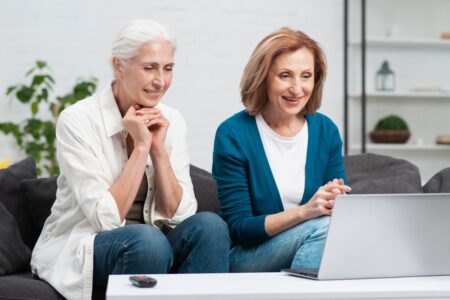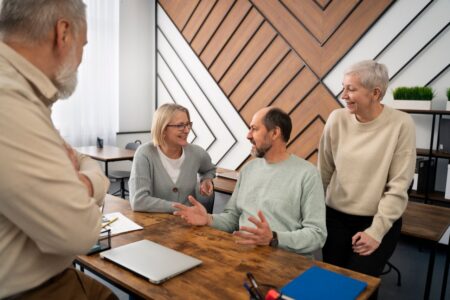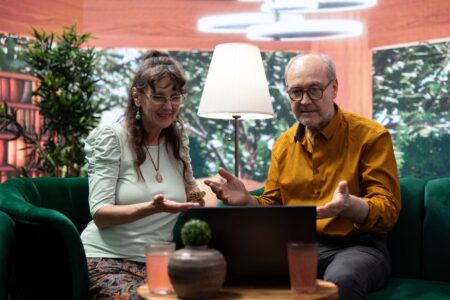For seniors today, it’s vital to understand basic computer skills. Understanding how to switch between desktop mode and multiple displays can further enhance your computer experience. Knowing the following shortcuts can make your day much better by enhancing productivity. Knowing how to use the File Explorer, taskbar, and keyboard shortcuts can make your day much better. Keyboard focus helps in navigating the user interface efficiently by allowing you to shift focus to different UI elements using key combinations. We’ll show you how to use these key parts, making computers simpler for you, especially in navigating the current folder and using the file explorer window.
Your desktop is where you’ll work with files, open apps, and get online. The taskbar is at the bottom of the screen. It has shortcuts to things you use a lot, like the Start button and the desktop button, which allow you to quickly access the active window. This makes finding and using programs like Internet Explorer or Microsoft Edge easy. These skills help beginners, especially older adults, and make computers easier for seniors.
Key Takeaways
- The desktop is your primary workspace for managing files and applications.
- The taskbar offers quick access to frequently used programs and functions.
- Understanding File Explorer helps you navigate and organize your files efficiently.
- Learning keyboard shortcuts can significantly boost your productivity.
- Basic computer navigation skills enhance the overall user experience.
Understanding the Importance of Computer Skills for Seniors
For seniors, learning computer skills is more than staying up-to-date. It’s about making life better and more independent. Knowing how to email, surf the web, and manage files like their documents folder, especially in tablet mode, makes seniors feel less isolated. It connects them with family and friends. Plus, being good with computers helps seniors not to fear tech. They can be curious and confident instead of scared.
Benefits of Learning Basic Computer Skills
There are many good things about seniors learning computer basics. It keeps their brains sharp and interested. Knowing how to use a computer connects them with loved ones through social media, emails, and video chats. Using the notification center and checking the system tray helps you stay updated with important alerts and messages. This helps them be more social. Also, they can do things like bank and shop online. So, they don’t need to leave their homes, especially when they can check updates in the notification area. Learning these skills means seniors can do more on their own. Additionally, knowing how to open settings allows you to customize your computer to better suit your needs.
Overcoming Fear of Technology
Technology can be scary for older folks. Learning commands to show or hide elements, like the Spotlight search field or the Dock, can help seniors feel more in control of their computer environment. But with kind help and regular practice, including learning the command line and screen recording, they can get past this fear. Learning tech starts with easy steps. Then, it gets a bit harder slowly. This way, seniors can feel sure of themselves. Kind words and support are important. They help seniors see the good in using technology. Once they’re not afraid, they can enjoy a life that’s more fun and connected.
Getting Started with Your Computer
Starting with digital tech involves a few easy steps. These steps can make you feel more confident and comfortable, especially if you use large icons . They will help you use your computer well.
Turning on Your Computer
The first thing is to turn on your computer. Find the power button on the laptop or desktop’s front or side. This basic step is especially important for the elderly. It prepares them for more tech interactions by familiarizing them with the navigation pane .

Logging into Your Account
After turning on your computer, it will ask you to log in. This keeps your settings and data safe. You’ll use a password or PIN for entry. This security step is crucial for seniors to protect files and personalize their tech experience.
Navigating the Desktop Environment
Learning to navigate your desktop is key for basic digital skills for seniors. Your desktop is the main space to open programs, files, and folders quickly. Knowing how to use desktop icons and manage the folder window can really make things easier.
Identifying Desktop Icons
Desktop icons are small pictures that represent programs, files, and shortcuts, often found on the left side of the screen. The menu bar at the top of the screen provides quick access to essential system features and shortcuts.
You may see icons like windows explorer and the recycle bin:
- My Computer: Gives quick access to your drives and system folders.
- Recycle Bin: Holds deleted files until you decide to permanently delete them.
- Software Shortcuts: These are icons for specific apps, like Microsoft Word or Google Chrome.
Knowing what these icons do is a big part of senior computer training. It helps you manage your work and find what you need faster, especially in the selected folder. Using the mouse pointer, you can easily click on these icons to open programs and files, including navigating to the previous folder.
Customizing Your Desktop
Personalizing your desktop can make using your computer more fun and efficient.
Here are some tips:
- Change the Background: Right-click the desktop, choose “Personalize” to pick a new background picture.
- Arrange Icons: Move icons around so they work better for you.
- Adding and Removing Icons: Add shortcuts for apps you use a lot, and get rid of the ones you don’t.
Making your desktop suit your needs can really boost how effective you are at using your computer. Getting comfortable with these basic digital skills for seniors will make navigating your desktop easy and fun while also allowing access to hidden files .
Exploring the File Explorer
File Explorer is a key tool for improving computer skills for older adults and managing your files well. It’s essential for those new to computers or wanting more control over their files. Mastering File Explorer and using windows media player helps a lot.
Accessing File Explorer
It’s easy to open File Explorer. The Address bar in File Explorer shows the folder path, helping you understand your current location within the file system. Simply click the folder icon on the taskbar or use the Win + E shortcut. You can also right-click on a folder and select pin to add frequently accessed folders to the Quick Access section. This action opens up your computer’s files and folders, crucial for learning computer basics as an older adult.
Opening File Explorer can also be done by clicking the Start button and selecting the File Explorer option.
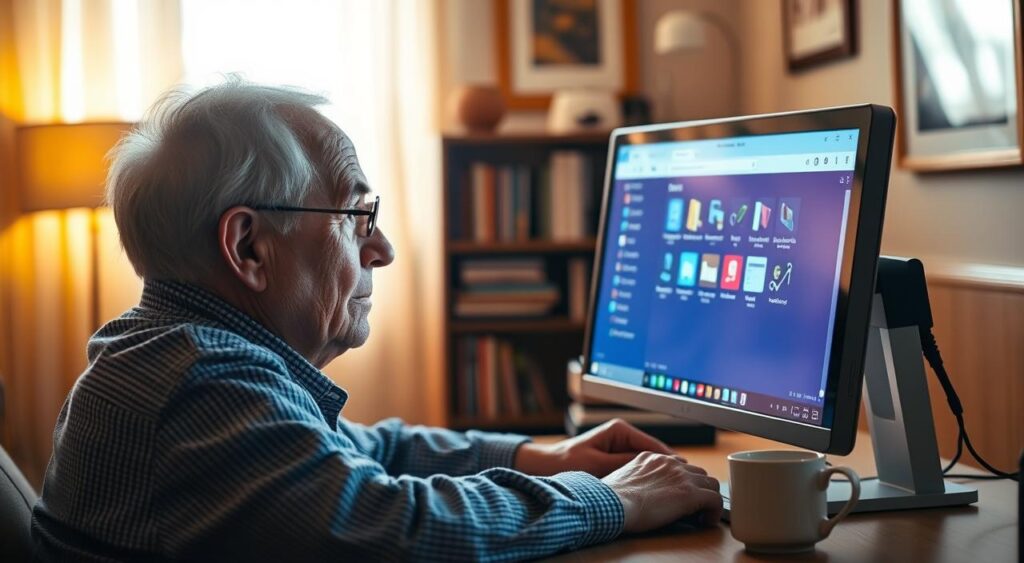
Understanding Folders and Files
Folders and files organize your computer. Folders hold related files, which can include various file types such as documents, images, and programs. Files are documents, images, or programs. This organization is vital for beginners, making it easy to store and find stuff.
Using the Search Function
The search feature in File Explorer is great for finding things fast. Just type in what you’re looking for. This is super helpful for older adults, as it reduces the need to look through many folders.
The Taskbar Explained
Getting to know the taskbar is key for seniors to learn tech skills easily. It’s the bar you see at the bottom of the screen. It lets you open apps and tools quick and easy. This makes learning to use a computer simple and efficient for seniors, especially when recognizing the windows logo .
What is the Taskbar?
The taskbar is crucial for managing your desktop. The Windows taskbar is a key element of the operating system, providing easy access to running applications and system notifications. It shows all the open windows, allowing for easy switching between them. Taskbar buttons allow you to quickly switch between open applications and access pinned programs. Additionally, the taskbar provides easy access to running apps, enhancing user accessibility and navigation. It also has the Start Menu button and icons that tell you about system notices and statuses.
Customizing Your Taskbar
Personalizing the taskbar can make learning tech easier for seniors.
Here’s how to make it suit your needs:
- Pin Applications: Right-click on an app and choose “Pin to taskbar” to get to it quickly.
- Adjust Position: Right-click, uncheck “Lock the taskbar,” then move it where you want.
- Change Color: Go to Settings > Personalization > Colors to pick a color you like.
These steps help you easily reach your most used apps and settings. They fit well with seniors learning tech skills.
Using Applications Effectively
Learning how to efficiently use applications is key for older people to improve their tech skills. A good first step is understanding how to open applications from the Start Menu and using the alt key for shortcuts .
Opening Applications from the Start Menu
For seniors, mastering how to open applications from the Start Menu is a basic yet crucial digital skill. Simply click on the Start button at the bottom-left of your screen. You can then scroll through the apps list or use the search bar to find what you need quickly. Clicking the app’s icon will open it. Clicking an app’s icon will open a new window for that application.
Getting to know the Start Menu can save you time and make using your computer easier. This familiarity with the Start Menu allows you to easily switch between different applications.
Pinning Applications to the Taskbar
To quickly access your most-used applications, you can pin them to the taskbar. Just right-click the app in the Start Menu and choose “Pin to taskbar.” This puts the app’s icon on the taskbar, so it’s just a click away. Doing this is a great way for older adults to enhance their tech skills and simplify daily computer use.
Pinning your favorite applications makes it easier to find and use them, keeping important tools at your fingertips.
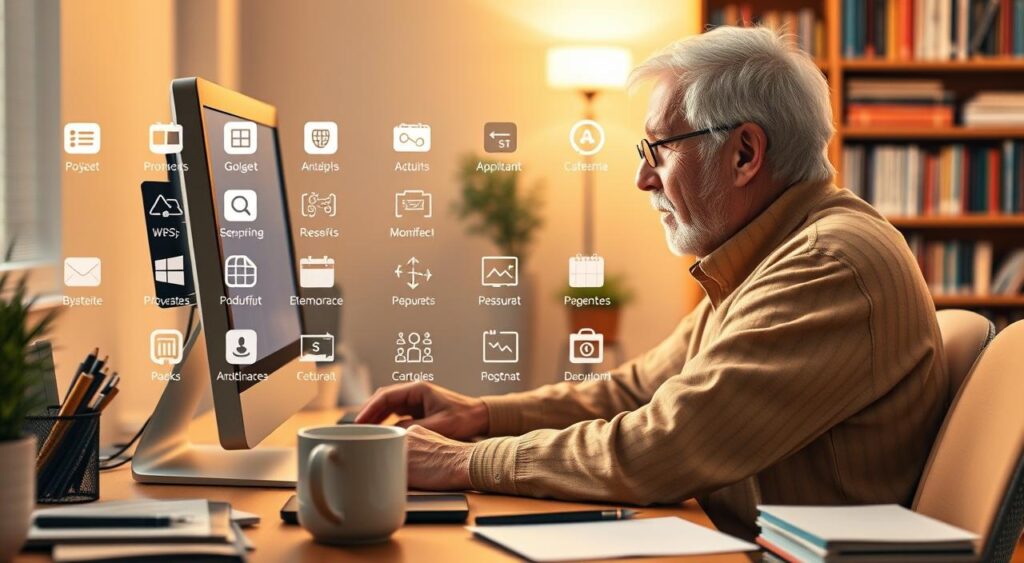
Managing Files and Folders
Learning to manage files and folders is key in senior computer classes. It helps you keep everything in order, making daily digital tasks easier. This organization leads to better productivity.
Creating and Organizing Folders
Making new folders is a must-know skill. To start, open File Explorer and right-click on a blank area. Choose ‘New’ and then ‘Folder’. Give your folder a clear name to reflect what’s inside. This process makes sure your files stay neatly sorted.
Moving and Copying Files
Moving and copying files is fundamental for seniors. To move a file, drag it to your chosen folder. Using the Option key while double-clicking can open items in a separate window, enhancing navigation. Or right-click, pick ‘Cut’, go to the folder, right-click again, and hit ‘Paste’. To copy, use ‘Copy’ instead of ‘Cut’. These steps let you organize your files with ease.
Getting the hang of these skills means you can tidy up your digital space. It makes using your computer easier and stress-free.
Essential Keyboard Shortcuts
Learning key keyboard shortcuts can greatly boost your computer use skills, especially using the taskbar button for quick acces . These shortcuts, including how to use search highlights, make up the core of computer basics for seniors. They help simplify and speed up many tasks.
Copying and Pasting
Knowing how to copy and paste is crucial in simple computer skills for elderly. The Ctrl key is often used in combination with other keys to perform actions like copying and pasting. Additionally, the up arrow key can be used in combination with other keys for efficient actions like maximizing the active window. To copy, press Ctrl + C. To paste, press Ctrl + V. This saves time retyping or making new documents. For example, using the Ctrl key with the left arrow key allows you to move the cursor to the beginning of the previous word.
Saving Your Work
It’s important to save your work often to prevent losing it. Press Ctrl + S to save quickly. This tip is a key part of computer basics for seniors that helps with understanding the operating system . It helps keep your work safe and allows you to manage how many windows are open at onc .
Undoing Actions
Mistakes are common when you’re learning. Use Ctrl + Z to undo mistakes. It’s a valuable shortcut in simple computer skills for elderly. It allows for easy error correction.

| Action | Shortcut |
| Copy | Ctrl + C |
| Paste | Ctrl + V |
| Save | Ctrl + S |
| Undo | Ctrl + Z |
Using the Search Function
Getting to know the search function is key for seniors learning about computers, especially how to open a new window . You can open it through the Start Menu or File Explorer, especially when using virtual desktops . It’s great for finding files, apps, and settings fast, which is really handy for older folks learning the basics.
Searching for Files and Apps
To look for files and apps, just click on the Start Menu at your screen’s bottom left. Windows Search allows you to quickly locate files, folders, and applications on your computer. Or, hit the Windows key on your keyboard. Then, use the search bar to type what you’re seeking. You’ll see matching results pop up as you type. Clicking the search icon on the taskbar opens the search bar, where you can type in your query.
In macOS Finder, you can enhance file browsing by using the preview pane. Pressing Shift-Command-P allows you to show or hide the preview pane, making it easier to view file contents without opening them.
Tips for Effective Searching
Here are some tips to make searching easier:
- Use clear keywords for what you’re looking for.
- Narrow your search by date, type, and size of files.
- If you don’t remember the full name, try parts of it or similar words.
- Sort your files in File Explorer to find them easier.
Using these tips can really help. It makes learning computer basics better for seniors. You’ll navigate and find things much easier, making your time online more fun.
Internet Navigation Basics
Learning how to use the internet is crucial for senior computer classes. Once seniors learn how to use computers, they can find lots of information and services easily.
Opening a Web Browser
To start exploring the internet, you first need to open a web browser. The Start screen provides a central hub for accessing your web browser and other applications. Browsers like Microsoft Edge or Google Chrome are easy to use. They have features to meet different needs. Just double-click the browser icon on your desktop or find it in your start menu. Your browser will then open ready for you to begin. If you are using an external display, you can also open your web browser on that screen for a larger view.
Understanding Bookmarks
Bookmarks are super helpful for all users, helping seniors easily visit their favorite sites again. To save a site, go to the page you like, click the star icon near the address bar, and name your bookmark. This makes browsing simpler and more fun.
Email Fundamentals
Email is crucial in today’s world, especially for seniors who wish to keep in touch. Learning to set up an email and use it for sending and receiving messages is key, especially when using the right arrow in navigation . These skills are part of the basic digital skills for seniors.
Setting Up an Email Account
Starting with an email begins by choosing a service, like Gmail, Yahoo, or Outlook. You then fill out a form with your details. You can adjust your email settings through the system preferences to better suit your needs. This includes picking a username and a strong password. These steps are necessary for computer basics for seniors. Additionally, you can adjust the sound volume for email notifications to ensure you don’t miss important messages.
Sending and Receiving Emails
Once your email is ready, learning to send and receive emails is your next step. To send, you write your message, put in the email address, and hit send. Checking your inbox often lets you see new emails. These abilities help seniors stay connected and handle their digital communications.
Troubleshooting Common Issues
Fixing common problems is key to keeping your computer in good shape. Learning simple tech skills helps older people fix small problems fast. Skills like restarting a computer or knowing when to call for help are important. They make sure your computer works well and efficiently.
Restarting Your Computer
Restarting your computer is a top way to fix many problems. It can solve temporary bugs or system crashes. Restarting clears running background tasks that might be causing problems. This is a great skill for older users to learn.
When to Seek Help
It’s important to know when to get expert help. If a restart doesn’t fix the issue, it’s time to see a professional if you have tried the left arrow troubleshooting methods . Don’t ignore ongoing errors, hardware issues, or complicated software problems. Knowing when you’ve reached your limit in solving problems helps keep your computer running well. This knowledge is crucial for seniors to maintain their computers.
FAQ
What is File Explorer and how do I access it?
File Explorer helps you organize your files in Windows. Find it by clicking its icon on the taskbar, or press ‘Win + E’.
What benefits do seniors gain from learning basic computer skills?
Basic computer skills can keep you connected with loved ones. They improve task management and make you more curious about tech. It’s also a confidence booster.
How can I overcome my fear of using technology?
Begin with easy tasks and practice often. Look for tutorials or classes for seniors. This will help make technology feel more welcoming.
How do I turn on my computer?
Press the power button on your laptop or computer. You’ll then log into your account, maybe with a password or pin.
How do I log into my account on my computer?
On startup, a login screen appears. Enter your password or pin there. This keeps your data safe.
How can I identify desktop icons?
Desktop icons represent different apps, files, or shortcuts. Places like ‘My Computer’ and ‘Recycle Bin’ are common. Move your mouse over an icon to see its name.
How do I customize my desktop?
Right-click on the desktop and select ‘Personalize’. You can then choose your favorite background, themes, and icon arrangements.
What is File Explorer and how do I use it?
File Explorer lets you manage your files easily. You can sort and find your digital files with it. Access it from the taskbar or by pressing ‘Win + E’.
What is the taskbar and what is its purpose?
The taskbar is found at the bottom of your screen. It shows open programs and has shortcuts for quick access.
How can I customize my taskbar?
Right-click the taskbar and go to ‘Taskbar settings’. From there, pin apps, adjust its position, and change colors to make it yours.
How do I open applications from the Start Menu?
Click the Start button to see the Start Menu. There, browse or search for apps and click to open them.
How do I pin applications to the taskbar?
Right-click an app in the taskbar and choose ‘Pin to taskbar’. This way, it stays there for fast access.
How do I create and organize folders?
In File Explorer, go to where you want a new folder. Right-click, choose ‘New’, then ‘Folder’. Name it and add files.
How do I move and copy files?
To move, drag the file to a new spot. To copy, right-click, select ‘Copy’, go to where you want it, then ‘Paste’.
What are some essential keyboard shortcuts?
Important shortcuts are ‘Ctrl + C’ for copy and ‘Ctrl + V’ to paste. There’s also ‘Ctrl + S’ to save and ‘Ctrl + Z’ to undo.
How do I search for files and applications in Windows?
Use the Start Menu or File Explorer search bar. Type in what you need. Sort results by date, type, or other filters.
What is the best way to search for specific files?
Use clear keywords for your file. In the search function, narrow results with sort options like date, type, or criteria.
How do I open a web browser?
Click the web browser icon, like Microsoft Edge or Chrome, on your desktop or taskbar to start browsing online.
How do I use bookmarks in my web browser?
To save a page, click the star in your browser’s address bar. Choose ‘Add bookmark’. It makes revisiting sites easier.
How do I set up an email account?
Pick an email service, go to its site, and fill out the sign-up form. Follow any steps to finish setting up.
How do I send and receive emails?
Log into your email on the provider’s site or app. Click ‘Compose’ for a new email and ‘Send’ to deliver it. Check ‘Inbox’ for new emails.
What should I do if my computer is not working correctly?
Try a restart first; it fixes many issues. If trouble stays, look up solutions or contact a professional.
How do I restart my computer?
Hit the Start button, choose the power icon, and pick ‘Restart’. It freshens your system and might fix glitches.




